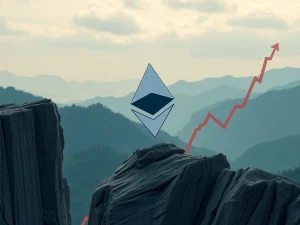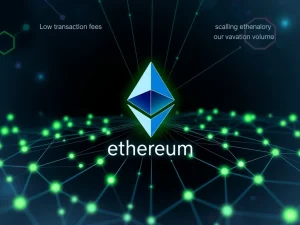Ethereum Price: Crucial Data Unveils Market Overreaction, Is $4.6K Recovery Next?

The recent Ethereum price plunge sent ripples across the crypto market. Many investors questioned the future trajectory of the second-largest cryptocurrency. Was this a genuine structural weakness? Or was it merely a fleeting market overreaction? Recent data provides crucial insights. It suggests that institutions might spearhead the next significant recovery.
Ethereum Price: Decoding the Recent Sell-Off
Ethereum price experienced a sharp 9.2% correction in under 12 hours. This move mirrored a broader risk-off sentiment across the cryptocurrency market. More than $500 million in bullish leverage positions faced forced liquidations. However, buyers quickly stepped in around the $4,150 mark. Traders now debate if the sell-off was excessive. They also wonder if further corrections below $4,000 are likely.
- ETH dropped 9.2% swiftly.
- This aligned with general altcoin movements.
- Over $500 million in bullish liquidations occurred.
- Strong buying interest emerged near $4,150.
The decline in Ethereum price was almost identical to the broader altcoin market. This indicates no specific concerns regarding the Ethereum ecosystem itself. Therefore, the dip appears more systemic than isolated. Furthermore, the quick recovery from the $4,150 level highlights underlying market resilience.
ETH Futures: Unpacking Open Interest and Leverage
ETH futures recorded significantly higher 24-hour liquidations. This largely reflected elevated open interest. It also showed wider use of derivatives like options. This was not necessarily a signal of excessive leverage from bullish positions. Aggregate open interest in Ether futures stood at $63.7 billion recently. In contrast, SOL, XRP, BNB, and Cardano combined for $32.3 billion. This data comes from CoinGlass. Importantly, ETH futures open interest remained relatively unchanged at 14.2 million ETH. This stability suggests that new leveraged positions balanced the liquidation effect. Consequently, the market absorbed the selling pressure without a dramatic shift in overall exposure. The high open interest indicates robust market participation rather than impending collapse.
ETH Derivatives Data: Gauging Investor Sentiment
To determine shifts in trader outlook, assessing the ETH derivatives data is essential. The ETH monthly futures premium offers a key indicator. Under neutral conditions, these contracts typically trade 5% to 10% above spot markets. This accounts for the longer settlement period. Strong demand for short positions can push the premium below this level.
- The annualized monthly futures premium for Ether dropped to a three-month low. This signals weak demand for leveraged long positions.
- The premium slipped below the 5% neutral threshold. This confirmed a lack of confidence from bulls since Saturday.
Furthermore, ETH derivatives data from perpetual contracts confirms this sentiment. The annualized funding rate in neutral conditions should range between 6% and 12%. Ether perpetual futures funding rate briefly fell to -6%. It later recovered to -1%. This metric had already dropped below the 6% neutral level earlier. This challenges the idea that cascading liquidations primarily stemmed from excessive bullish leverage. Therefore, the dip likely originated from spot market selling, amplified by derivative reactions.
Crypto Market Sell-Off: Beyond the Panic
It remains possible that a small group of entities held overly optimistic positions. However, the initial trigger for Ether’s weakness is unclear. It appears to have led other cryptocurrency traders to panic sell. This suggests a broader crypto market sell-off driven by fear. Ether options provide another way to test professional trader anticipation. If advance positioning had occurred, demand for put (sell) options would have spiked. This would be compared with call (buy) contracts. A ratio above 150% favoring puts typically signals strong fear of a correction.
On Deribit, the put-to-call Ether options volume hovered near 80%. This was consistent from Wednesday through Sunday. It aligned with the 30-day average. Overall, ETH derivatives data shows weakening demand for bullish exposure. Yet, it indicates no derivative markets were the origin of the downturn. Instead, evidence suggests futures liquidations resulted from panic selling. This temporarily dampened risk appetite. Still, this should not be a long-term concern. Ether’s move aligned with major altcoins, suggesting a market-wide phenomenon.
Spot Ethereum ETF: A Catalyst for Recovery?
The case for ETH regaining $4,600 remains strong. This outlook is supported by rising corporate reserves. Moreover, growing demand for a Spot Ethereum ETF is a significant factor. Institutional interest continues to build for Ethereum. A spot ETF approval could unlock substantial capital flows. This would further validate Ethereum as a mainstream asset. Therefore, while recent volatility tested investor resolve, the underlying fundamentals for Ethereum appear robust. The market correction seems to be an overreaction. It may instead pave the way for a solid rebound. Institutional demand is likely to lead this recovery. Many anticipate the positive impact of such an ETF on market sentiment and liquidity.
Conclusion: Navigating the Future of Ethereum Price
The recent Ethereum price volatility highlights the inherent risks in the crypto market. However, a deeper look into ETH futures and ETH derivatives data suggests a broader market panic, not a fundamental weakness in Ethereum. With increasing corporate reserves and the anticipation of a Spot Ethereum ETF, the stage is set for a potential recovery. Investors should monitor institutional movements closely. These could signal the path back towards the $4,600 mark and beyond. Ultimately, Ethereum’s ecosystem strength and growing institutional adoption paint a promising long-term picture despite short-term fluctuations.









